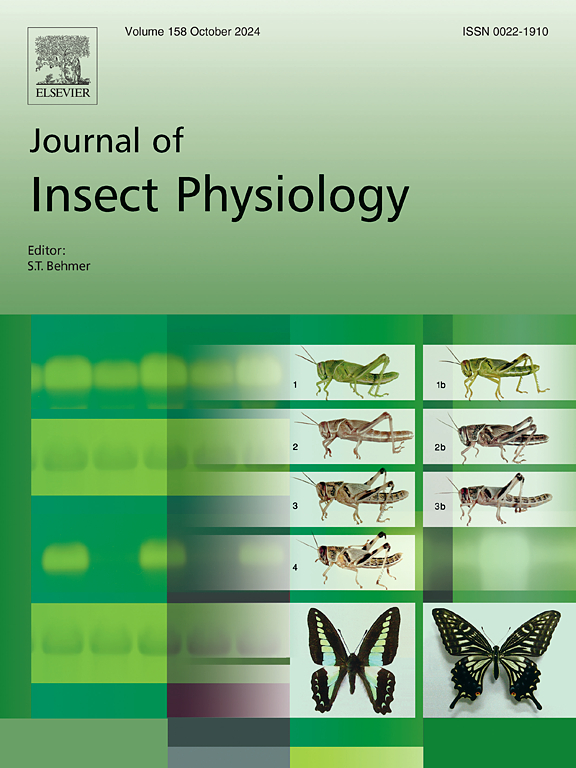秋粘虫体内甾醇营养的调控。
IF 2.3
2区 农林科学
Q1 ENTOMOLOGY
引用次数: 0
摘要
植物甾醇是食草昆虫唯一的甾醇营养来源,但植物甾醇含量复杂多变,昆虫甾醇营养调控机制尚不清楚。在这项研究中,我们利用几何营养框架研究了水果夜蛾的胆固醇调节。在选择实验中,我们给幼虫提供了8对食物。这些昆虫并没有调整它们对这两种辅食的摄取量来达到特定的胆固醇摄入量目标。在无选择实验中,研究人员使用了七种不同胆固醇浓度的食物来探索胆固醇的调节作用。幼虫没有表现出减少或增加非胆固醇营养素摄入量以达到一定胆固醇摄入量的趋势。然后,我们测量了NPC1b基因在肠道中的相对表达量和粪便中的胆固醇含量。随着食物中胆固醇含量的增加,NPC1b基因表达量逐渐降低,幼虫粪便中胆固醇排泄量增加。同时,幼虫体内胆固醇含量基本保持一致,说明幼虫对体内胆固醇含量有较强的控制作用。总之,我们的研究结果表明,幼虫通过平衡胆固醇的摄取和排泄来调节胆固醇的体内平衡,胆固醇水平可以保持在生理上适当的范围内。本文章由计算机程序翻译,如有差异,请以英文原文为准。

Regulation of sterol nutrition in the fall armyworm, Spodoptera frugiperda
Plant sterols constitute the sole source of sterol nutrition for insect herbivores, yet the sterol content of plants is complex and variable, and insect sterol nutrient regulation remains to be elucidated. In this study, we investigated cholesterol regulation in Spodoptera frugiperda using a geometric framework for nutrition. In the choice experiment, we provided larvae with eight food pairings. The insects did not adjust their feeding on the pair of complementary diets to achieve a specific cholesterol intake target. In the no-choice experiment, seven foods with different cholesterol concentrations were administered to explore sterol regulation. The larvae did not show a tendency to reduce or increase their intake of non-cholesterol nutrients to reach a certain cholesterol intake. We then measured the relative expression of the NPC1b gene in the intestine and the cholesterol content of the feces. As the cholesterol content in the food increased, NPC1b gene expression gradually decreased and the larvae excreted more cholesterol in the feces. Meanwhile, the cholesterol content in the larvae remains largely consistent, indicating that the larvae has a strong control on the body sterol content. Altogether, our results suggest that the larvae regulate cholesterol homeostasis by balancing cholesterol uptake and excretion, and cholesterol level can be kept within a physiologically appropriate range.
求助全文
通过发布文献求助,成功后即可免费获取论文全文。
去求助
来源期刊

Journal of insect physiology
生物-昆虫学
CiteScore
4.50
自引率
4.50%
发文量
77
审稿时长
57 days
期刊介绍:
All aspects of insect physiology are published in this journal which will also accept papers on the physiology of other arthropods, if the referees consider the work to be of general interest. The coverage includes endocrinology (in relation to moulting, reproduction and metabolism), pheromones, neurobiology (cellular, integrative and developmental), physiological pharmacology, nutrition (food selection, digestion and absorption), homeostasis, excretion, reproduction and behaviour. Papers covering functional genomics and molecular approaches to physiological problems will also be included. Communications on structure and applied entomology can be published if the subject matter has an explicit bearing on the physiology of arthropods. Review articles and novel method papers are also welcomed.
 求助内容:
求助内容: 应助结果提醒方式:
应助结果提醒方式:


